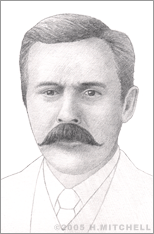John Milne
Geologist and engineer John Milne is known as one of the most significant contributors to the understanding and evaluation of earthquakes. He compiled a substantial body of observational research, developed the first international network for seismological data, and created what may be considered the world’s first modern seismograph.
Born on December 30, 1850 in Liverpool, England, Milne attended King’s College and the Royal School of Mines, where he earned the credentials to become a mining engineer. He first began working in Europe, performing mineral investigations for mines there and later, in Newfoundland. He also participated in an 1874 mining expedition to Sinai.
At the age of 25, he accepted a professorial post at the newly established Imperial College of Engineering in Tokyo. He took an adventurous 11-month overland journey to get there, traveling across Siberia and arriving in Japan in 1876. An earthquake occurred there on his very first night.
The study of earthquakes was relatively new then. It became a field of its own only in the mid-18th century when a series of major quakes that hit England in 1750 was followed by a quake and tsunami in 1755 that devastated Lisbon, Portugal and killed nearly 70,000 people. At this time, scientists began compiling observational data on quakes around the world, and as international communications improved, more and more information could be combined.
After a quake hit Yokohama in 1880, Milne, along with British colleagues James Alfred Ewing and Thomas Gray, initiated the founding of the Seismological Society of Japan, the world’s first seismological society. He was asked to lead the organization, but he opted to edit and write for its journal instead.
Among the society’s aims was the funding of seismograph development for earthquake measurement and detection. Working with Ewing and Gray in 1880, Milne invented a simple horizontal pendulum seismograph, a machine that records vibrations that occur with sudden movement along a fault line in the earth. These waves of motion can be one of two varieties: primary ("P waves") or secondary (“S waves”), which move at different speeds. Primary waves move in a compression/expansion type of pattern and appear as wavy lines on a chart. Secondary lines, which are generally detected later than primary ones, are more snake-like, moving in a ragged sort of fashion. Examining both types of waves together allow scientists to determine the distance of a quake’s epicenter from the measuring station.
Milne compiled many volumes of data on Japan’s earthquakes and wrote two of the field’s standard works, “Earthquakes” and “Seismology.” In 1895, a fire destroyed his home, laboratory, and library. He was devastated by the event and decided to return to England to start anew with his Japanese wife, Tona. He set up a laboratory in his home on the Isle of Wight, called Shide Hill House, which became a world center for seismological research for the next 20 years.
“Earthquake Milne,” as he came to be known, operated a seismograph station and conducted many other seismological experiments. He secured funding from the Royal Society to fund earthquake observatories around the world equipped with his seismographs. Locations grew from 20 to 40 and included England, Russia, the United States, Canada, and Antarctica. The worldwide nature of this network was critical for collecting data to provide global patterns for earthquake activity, which could then be evaluated at a central location. It also allowed for “remote sensing,” or measuring earthquakes felt in one area of the earth in another region in a uniform fashion.
In 1896, while on vacation in the Isle of Wight, John Johnson Shaw paid Milne a visit that resulted in a lifelong partnership. The pair collaborated on a machine dubbed the Milne-Shaw Seismograph, which launched in 1913. In subsequent years, improvements to the seismograph were made by others, including Emil Wiechert and Boris Galitzin, whose electro-magnetic version changed the way they were built forever. Still, weighted bases, recording needles, and seismograms – the drawings that the machines make on paper – remain key components of today’s seismological devices.
Milne held the position of Secretary of the Seismological Committee of the British Association until his death from kidney disease on July 31, 1913. In 1919, his laboratory operations were transferred to Oxford University.


